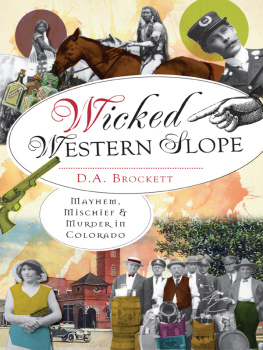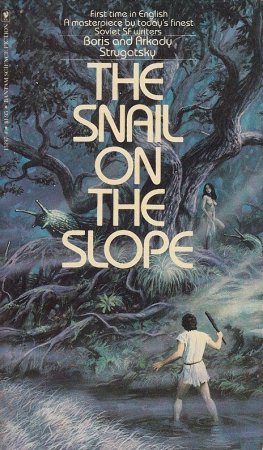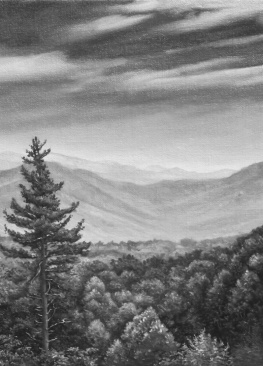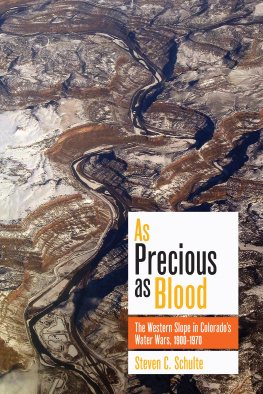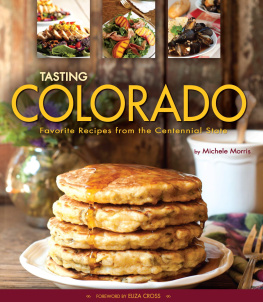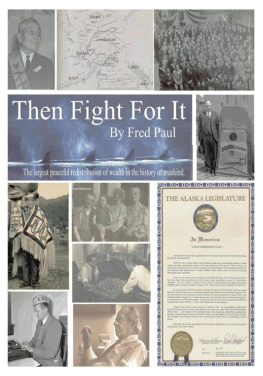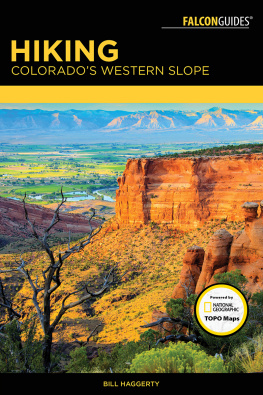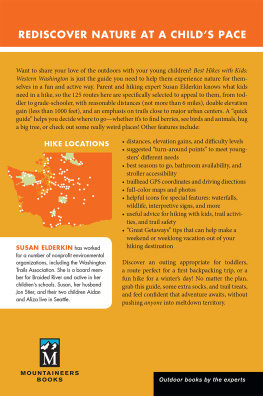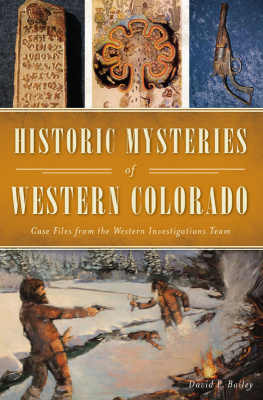

Published by The History Press
Charleston, SC 29403
www.historypress.net
Copyright 2012 by D.A. Brockett
All rights reserved
First published 2012
e-book edition 2012
ISBN 978.1.61423.575.0
print ISBN 978.1.60949.570.1
Library of Congress CIP data applied for.
Notice: The information in this book is true and complete to the best of our knowledge. It is offered without guarantee on the part of the author or The History Press. The author and The History Press disclaim all liability in connection with the use of this book.
All rights reserved. No part of this book may be reproduced or transmitted in any form whatsoever without prior written permission from the publisher except in the case of brief quotations embodied in critical articles and reviews.
This book is dedicated to the Museum of Western Colorados Loyd Files Research Library and to curator Michael Menard. He and his dedicated staff selflessly carry the Western Slopes past into the present and guard it for the future. We should all be thankful.
Contents
Acknowledgements
This book couldnt possibly have been written without the support of my family. Ben and Lily, thank you for sacrificing home-cooked meals, made beds, playtime and loving attention. Youre the best! Also, Id like to thank the following family, friends and colleagues: Steve Henderson, your humor and insight are always sought after and treasured; Garry Brewer, one of my favorite history buds and finder of interesting stories and pictures, some of which were used in this book; Steve and Denise Hight, for insights into Fruita history; Nancy Larson, of the Colorado Prison Museum, for going above and beyond the call of duty to get a picture to me; to Jim Rudnick, Matt Carson, Thelma Liggett, Dorothy Doyle, Darel Paul, Donna Patton, Teri Huff, Susan McCleerys family and especially Michael Menard, curator of the Loyd Files Research Library at the Museum of Western Colorado, I deeply appreciate the pictures you allowed me to use for this book. Thanks, also, to Dr. Robert Kurtzman for answering a medical question for me. Thank you, Priscilla Mangnall and Chris Brown, dear friends and fellow history lovers, for including me in your own history treks over the years. Youve helped keep me writing at my computer! Thanks go to my editors, Becky LeJeune and Hilary Parrish of The History Press, for your professional input and care. Lastly, Id like to thank all who encouraged me to write another book on western Colorado history. Your kind sentiments make all the hard work worthwhile.
Introduction
Why write a book about early crime on the Western Slope? Certainly not to glory in the gory details. Crime through the ages has shown the trickle-down effect of how the world, as a whole, was doing. For instance, during World War II, there was little crime here, presumably because most of the crooks took their villainous proclivities across the oceans. When the war was over, crime came home, gearing up to ruin Dick and Janes idyllic lives.
Eras of crime reflect the times. Horse thieving was prolific in the old West, but there was the occasional white-collar crime. Then, a horse was transportation, the ability to work the land and money in the pocket. One can almost understand why people were killed over the loss of a horse back then. Today, a stolen horse is a rare thing, and murder over it is even rarer. But in a world of exploding information and the Internet, white-collar crimes are at tsunami proportions.
The first newspaper in town, the Grand Junction News, meticulously reported on every little jot and tittle. However, where early crime was concerned, its editors either played it down or reprimanded the miscreants like outraged mothers. Not that they were soft on criminals or overly judgmental. They were trying to grow the valley, and how would it look to the outside world if the area was flush with iniquity or didnt take a stand for propriety?
Much credit for weathering early Western Slope life goes to the News. There was no denying the harsh existence, and to withstand the disappointments and dismay, a certain amount of humor was needed. Edwin Price and D.P. Kingsley doled out the news in carefully modulated columns. They were in the unique position of impacting a towns future with the truth while discouraging the weary masses from leaving. Humor was the key. If they could banter about the buffoonery, then the readers could, too. It worked, and a strong communal bond was woven throughout the valley.
This book reflects the different decades of an emerging metropolis. Youll find some quoted colloquial terms offensive, but theyve been included to show how we, as a society, have grown regarding prejudicial behaviors. Like a modern police blotter, these stories have tragedy, murder, rape and atrocities of every ilk. Some take a cue from the News and celebrate the funny side of seriousnessfor, as Roman Gary wrote, Humor is an affirmation of dignity, a declaration of mans superiority to all that befalls him. Most importantly, youll understand how the determination, wisdom, dedication, strength and vision that a tenacious group of people embraced created a successful society, in spite of the dark times.
Chapter 1
I Fought the Law and
HOTHEADS, INC.
Not much went on in the way of crime during the inaugural year of Grand Junction. Cabin raising, business building and surviving the elements were at the top of the to-do list. Important businesses were established first. A bank, livery, grocery store and plenty of saloons dotted the sagebrush corridor dubbed Hoodoo Avenue. Emma Thompsons log cabin saloon was always busy, day and night. The first recorded shooting in town took place there on Thursday, November 10, 1882.
Earlier in the week, on election night, an earthquake had rocked the town and rattled the nerves of residents. By Thursday night, tempers were short, and two menMike Dunn, a young railroader whod been sacked earlier in the week, and a gambler named Broken-Nose Simsgot into it. Sims pulled out his gun and shot at Dunns retreating body as he exited the back door. The gambler missed, but panic ensued in the smoky room.
As people stumbled around, Kitty Sheedy, a prostitute, fell and broke her arm. When Marshal Jim Davis barreled in to see what in tarnation was going on, the crowd pointed at the back door and shouted, Arrest that man, for Gods sake!
Davis skimmed out the back door and saw Dunn running down the alley. He hollered for the man to stop, but he was too scared and kept his pace. Davis opened fire, and Dunn slammed to the ground, a bullet in his back. The doctor was called for, and he transferred Dunn to the nearby hospital at the southeast corner of Second and Colorado. Not to leave any loose ends, Sims was secured in jail to await a preliminary trial. It was only then that Marshal Jim Davis turned himself over to Deputy Sheriff Brown.

One block south of Main Street, Colorado Avenue was dubbed Hoodoo Avenue for its crime element. This photo was taken in 1882 and was the original business section. As saloons and brothels flourished, especially in the early years, reputable businesses happily migrated to Main Street when it began to be developed. At this corner, the mans back is facing Emma Thompsons Saloon. Courtesy of Loyd Files Research Library
Next page
